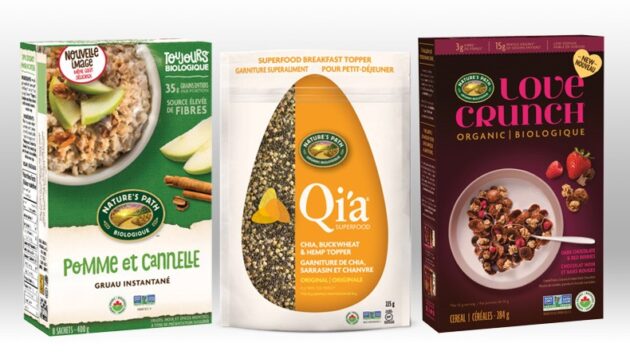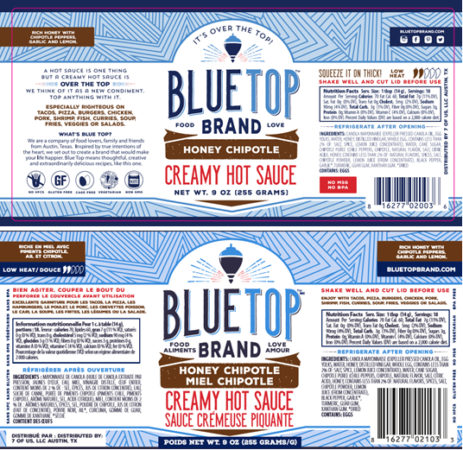
Top Five Canadian Labelling Must-Haves
By Laura McLeod
From bilingual labels to the nutrition table, we provide tips to help you navigate Canadian labelling requirements for a successful product launch.
If you are getting ready to launch a packaged product into Canada, the regulatory environment can be challenging to navigate. And if your packaging and labels don’t meet Canadian requirements, distributors may refuse to carry your product. Save yourself time, money and frustration by getting things right the first time.
Here are some things to keep in mind:
1) Everything must be translated

Food products being sold in Canada must meet bilingual language requirements.
A Canadian label must always be bilingual, with very few exceptions. This means the text, as well as any units relating to measure, and any icons or badges displaying claims like “gluten free” must all be translated. Keep in mind that the translation must be done in Canadian French to be appropriate for Québec. There are subtle differences between European French and Canadian French and the two are often not interchangeable.
2) Localization is crucial
Not just any old translation will do. Word-for-word translation often won’t cut it, as it won’t express the nuance of what you are trying to communicate — which could mean the difference between your product being embraced or shunned by buyers. Don’t risk your product launch by cutting corners on translation. Invest in professional translation by native language speakers, with proper quality control measures in place. Also, be aware that units of measure must be presented in metric for products being sold in Canada. A quality translator with experience in localization and Canadian packaging will point out all of these details to you as you move forward with your project.
3) Labelling must comply with Health Canada requirements
All products being sold in Canada must meet requirements of Health Canada. If your product originates in the United States and your labels were designed with the Food & Drug Administration (FDA) in mind, there are some important differences. For example, in the U.S. there is a requirement to label genetically modified or bioengineered foods, but this is not required in Canada. However, in Canada there are quite specific requirements around the nutrition table. For example, you cannot make a claim that a product is high in a mineral or vitamin, such as calcium, unless you are listing the quantity present in the nutrition table to back up your statement. It’s important to understand all of these nuances before you begin.
4) Design matters

French language requirements greatly increase the amount of text that must be on a label, posing some graphic design challenges. Above, the original English version of a package, along with its bilingual counterpart. Image source: LAT Multilingual
French content is roughly twice as long as its English equivalent, so your graphic designer will need to carefully consider placement and layout, and make modifications to allow for the extra word count — without having everything look awkwardly crammed together, and without removing mandatory information. For best results, ensure that your original design has the flexibility to accommodate this requirement, and leave some room in your budget for refinements during this process. Also, if you have your own designer, always make sure your translator does a final quality assurance check after the translated text has been typeset. It is easy for things to be put in the wrong spot, or words to be left out, so this is an important step before your packaging and labels are signed off and sent to print.
5) Don’t forget Quebec
If you’re taking the trouble to adapt your labels to meet the Canadian market requirements, make sure you also meet Quebec’s language requirements, under The Charter of the French Language (Law 101). The latter are a bit stricter, but going the extra mile is worth it. Quebec represents a market of over 7 million customers who are known for their epicurean lifestyle and brand allegiance. Some of the additional requirements under Law 101 include that French must have “greater prominence” on packaging that has multiple languages, and instructions must be included in French. As well, if you are considering marketing or advertising campaigns, you will want to ensure that your ad copy has been properly localized, not just translated, so that it resonates with this sophisticated and discerning market.
Labelling regulations provide an essential service by ensuring that consumers can find consistent, accurate, and legible information on packages. However, navigating the regulatory landscape on your own can be intimidating. Our advice? Get help from a translation and marketing agency that understands Canadian labelling regulations and has recent, relevant experience in the industry you represent. You will find that with a bit of help along the way, your product’s pathway to market shelves will be much smoother.
Laura McLeod is the Communications Manager for LAT Multilingual Translation & Marketing, which provides quality translation, adaptation and cultural marketing services to a wide variety of clients. LAT has extensive experience in all things Canadian-–with expertise in reaching French and Chinese Canadians to help companies grow brand awareness and sales. Their bilingual packaging clients include McCormick & Company, Nature’s Path, HAIN Celestial and KAO (representing several brands, such as Jergens and Bioré). www.latmultilingual.com.
Advertisement

